Slow Food Fast
September 14th, 2007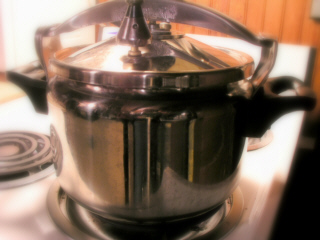
Occasionally, an article about favorite kitchen tools grabs our attention. You know the sort: it starts with “Now, Martha (or Wolfgang, Rachel, or Emeril) what’s your favorite kitchen tool? What’s the one tool you absolutely will not live without? If you were stranded on a desert island with a Weber Kettle Grill, 10 Lbs. of New York strip steaks, a pound of butter, and some white truffles, and could have only one tool, what would it be? When you cook, what tool is sine qua non for you?”
A surprising number of people answer that question by saying, “my microplane grater.” In fact, one of the people who gives that answer lives here in this house. I find this surprising, though, because as an Italo-centric cook, I grate only so many foodstuffs as part of my normal routine. But for my cooking cohort with Asian-fusion tendencies, the microplane grater was so life-changing that the quantities of finely chopped ginger we were accustomed to producing are now microplaned ginger, which shows up in everything from our iced-tea to guacamole.
But since the question has come up, MY favorite kitchen tool is the pressure cooker. Of course you may say that it’s an awfully arcane piece of equipment, the sort of thing your grandmother used. You will very likely have a story—real or apocryphal—about someone who spent a half day sponging pea soup off the kitchen walls and ceiling after “the pressure cooker exploded.”
We are happy to report that technology has come a long way since grandma tended the stove. The way a pressure cooker works has not changed, but the engineering has been greatly improved.
In brief, a pressure cooker’s job is to substantially reduce the time required to cook foods like pulses and tougher cuts of meat that would ordinarily take hours.
The essential elements are liquid and pressure.
When heated, liquid inside the pressure cooker’s pot creates steam and a certain amount of pressure. Modern cookers are engineered to produce 15 Lbs. of pressure per square inch at sea level. When it reaches that point, a liquid boils at a higher temperature: 257 ° F. Any excess steam generated by the boiling liquid is vented through the pot’s lid. Food cooks more quickly. A typical “braise,” that might take 2-3 hours on the stove or in the oven is done in an hour or so.
I got my pressure cooker at a hardware store in the south of France. While the town of Grasse is world-renowned for its large perfume-making operations, I remember it more for its hardware store than for the jasmine samples at Fragonard.
The fact that European hardware stores often sell cooking utensils and that the French call a hardware store a droguerie, were enough to make me seek them out everywhere I went in Provence.
My model was made by Moulinex, and in France anyway, is yet another of so many kitchen tools known simply as a mouli. Think of how Italians use the term machinetta to refer to any small machine from an espresso pot to a Fiat.
If Labor Day marks the end of summer, it also heralds the beginning of the season of “bean cuisine,” in cooler climes. But because our air-conditioner is still kicking on for much of the afternoon, we were inspired to do a little experiment to see if we could keep our kitchen cool and save energy while still cooking our beans.
Ordinarily, Italians don’t soak beans overnight, but rather, cook them for 10 minutes at a full, rolling boil before moving on to the rest of a recipe. We asked ourselves what would happen if we gave the beans those first 10 minutes under pressure. Then, we went a step farther: we let them sit—sealed in the thick, heat-retentive pot and off the burner. After four hours, we opened the still-warm pressure cooker and found the beans were completely cooked. This was a great surprise. Not only were we saving energy, but we weren’t even heating the kitchen enough to trigger the air conditioning. And we had a supply of perfectly tender cannellini that would make at least two, and possibly three, meals.
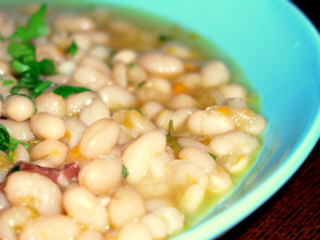
So for 10 minutes of cooking under pressure and an afternoon of benign neglect, we were poised to make nearly instant fagioli al uceletto, beans with tomato sauce; insalata di fagioli e tonno, tuna and bean salad; and zuppa di fagioli, bean soup. The list goes on…
We’re not sure how long cooked beans will keep in the fridge. With our culinary styles (Italian, Middle Eastern, and Indian), we tend to use them up in a couple of days. At lunchtime, it’s a simple matter to chop a sweet Florida onion, open a can of tuna, and snip a few sprigs of rosemary for a satisfying Tuscan lunch. Bean soup is merely a batutto—chopped pancetta, carrot, celery, onion, garlic, and parsley quickly sautéed—added to a bowl of warmed beans.
Today’s pressure cookers are sleek, efficient, and safe. And, for those of us with an interest in saving energy, they provide a great way to cook slow food fast. It goes without saying, though, that when we serve our zuppa di fagioli, we’ll garnish each bowl with a shower of Parmigiano from our microplane grater.
Dinner Dance
September 10th, 2007
We love wines made from the malbec grape and just bought one new to us at the monthly tasting we attended Saturday at our nearby fine-wine boutique, Michael’s Wine Cellar: Felipe Rutini 2004 from the Rutini family’s La Consulta vineyards in the Mendoza region of Argentina.
Michael Garey, representing, Transatlantic Wine and Spirits, was pouring samples at his table. For our taste, we found the Felipe Rutini to be the class of the field and favored it over several fine California and French Cabernets (Transatlantic was one of eight distributors, each of whom offered half a dozen wines.). We thought the malbec would pair well with the Asian-fusion fish we had planned for the evening. Yes, fish!
Because malbec is virtually synonymous with the wines of Argentina, wines made from it are usually suggested as accompaniments to grilled steaks and other flavorful red meat dishes, for which Argentina is also renowned. But we think the spice and berry notes of malbec also complement assertive Asian flavors—specifically garlic, ginger, and Szechuan pepper.
Most often, wine sellers, food writers, and restaurant staff counsel diners to pour a fruity white—like a Gerwurtztraminer or Semillon—with Asian food. That’s when they are not suggesting something fizzy—a sparkling white or beer. We think that a balanced red wine can be a more interesting pour, especially when a dish contains flavorful fats.
Steelhead trout has a high fat content and browns easily in a sautée pan, without need for additional oil. In fact, it releases enough fat to stir-fry accompanying vegetables. We’d served Shiraz and lighter zinfandels with grilled salmon and were keen to experiment with a malbec. So, this is what we did:
An hour before cooking, we gave our red-fleshed, skin-on trout filet a light coating of ground black peppercorns, Szechuan pepper, minced garlic & fresh ginger, and a pinch of salt. The fish went back into the fridge till frying time. Our very simple treatment took just a few minutes. Later (after our usual evening swim), all we needed was 20 minutes before dinner was ready to serve.
First we parboiled, rinsed, and set aside some Japanese soba (buckwheat noodles).
In a non-stick pan over medium-high heat, we browned the steelhead trout, skin side first. When the fish was nearly done, we set it aside. The pan had just a light coating of released fish fat, enough for us to stir-fry a little more chopped garlic and ginger, slivers of red bell pepper, slices of star fruit, and whole leaves of baby bok choy. The star fruit gave up a little of its distinctive astringent, floral juice, but kept its shape.
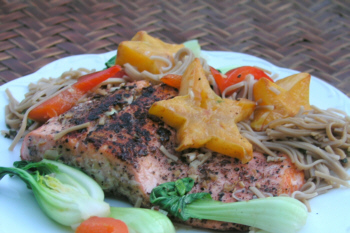
To pull it all together, we slid the noodles into the pan with the vegetables to warm them through as we added dashes of soy sauce, toasted sesame oil, and our own basil-infused vinegar. Snipped fresh basil leaves and some grated lime-rind finished the dish.
We poured our malbec and sat down to the fish with its colorful accompaniments. The silky trout and earthiness of the buckwheat soba were absolutely right with the malbec—dark, a little smoky, with some bite and spice. Altogether, a very satisfying tango.
Again, the wine we purchased and poured was 100% Malbec, Felipe Rutini 2004 La Consulta vineyard in Mendoza ($15.95 at Michael’s Wine Cellar in Sarasota).
Technorati Tags: Sarasota, Steelhead Trout, Malbec, Wine Pairing
Our Star Fruit Vinegar Experiment
September 9th, 2007“What is sweeter than honey? Free vinegar.” — old Turkish riddle
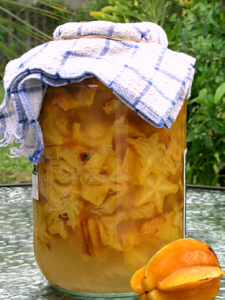
We’ve recently found ourselves with a surfeit of star fruit (Averrhoa carambola). Due to the benign neglect of some of our neighbors, scores of ripe fruits have fallen to the ground in three different yards along our regular walk-routes (some might say trade routes).
At first, we were delighted, eating sliced stars with yogurt for breakfast, or simply on their own, as a snack. But it’s not taken us long to discover an even better use for our bounty. We’ve written elsewhere about the pitcher of tea in the fridge. We enjoy our chilled tea throughout the day, and as we use various fruits like lemons, limes, and mangoes, we add their rinds, pits, and additional freshly brewed tea to the pitcher. The process is not unlike enriching the apocryphal stock pot, simmering on the back burner, with vegetable trimmings.
When we began adding cut-up pieces of star fruit to our tea, we noticed that the tea was rapidly infused with the fruit’s flavor. This caused us to consider using star fruit as a basis for vinegar…
Last night, we got a percussive suggestion that perhaps star fruit would be a good candidate for the vinegar jar. While sitting quietly in the living room, we heard a sharp pop from the kitchen. The source of the explosion was the recycled yogurt container we keep in the kitchen sink for compost material. We had cut up several star fruit earlier in the day, and the scraps in the covered plastic container had already produced enough CO2 to pop the top off. Might this be an enthanol alternative?
We’ve been making our own vinegar since we lived in Connecticut, when one of us concocted a batch from white zinfandel wine. We’ll never forget the words of the fellow at the liquor store when we bought the wine to start the project: “Oh, so there really is a use for Sutter Home White Zin?”
No matter what anyone thinks of the wine, it makes fabulous vinegar.
That first batch set the tone for all our subsequent vinegar-making endeavors. We take neither the vinegar, nor ourselves, too seriously and get great results. A couple of years ago, we found the Web site of a group of like-minded people who call themselves the Gang of Pour. They don’t take themselves too seriously either. In fact, one of their members wrote that she’d started making vinegar with a mayonnaise jar and some leftover wine. And that’s fine by us, because levity makes any seemingly arcane process much more approachable.
We began experimenting with vinegars from the fruit we grow in our back yard here in Sarasota. Our citrus trees are old yet extremely prolific. Each winter, we try hard to share our grapefruit with anyone we know, but in a county where half the population is on Lipitor® (for which grapefruit consumption is contraindicated), this is not easy and we end up with a lot of fruit. Our citrus are delicious, but the unnamed cultivars with which we are blessed are extremely seedy, so we juice most of our oranges and grapefruit. And because we end up with a lot of juice, we have experimented, turning out a serviceable orange vinegar as well as a terrific grapefruit vinegar.
It’s simple enough: we begin with a scrupulously clean, wide-mouthed jar, then add fruit juice and our “starter”—unfiltered and unpasteurized cider vinegar in proportions of about 6:1. We cover the mouth of the jar with cloth or a paper coffee filter (secured by a rubber band), stash the jar in a dark place, and check on it from time to time. We’re told that the optimum temperature for making vinegar is approximately 70° F. But since our house has an ambient temperature of about 80° F., the process doesn’t take quite as long. For us, the vinegar is usually ready in about two weeks.
It’s been a few months since our last grapefruit, so we were ready for a new undertaking. Heading out with a plastic bag and plying our neighborhood trade routes, we collected approximately 6 Lb. of fallen star fruit. We picked through our haul, saving the most pristine specimens for culinary uses, then sliced the rest to fill a one gallon jar, nearly to the top. We added just enough Brita-filtered water to top off the jar, and then added a ‘mother,’ a piece of the leathery starter that had grown and completed its mission in another project, a jar of red wine vinegar.
This latest vinegar venture is a departure for us, as it is both infusion (adding something aromatic to, say, white wine vinegar) and fermentation (adding a catalyst and letting Mother Nature do the work). We’re hoping that the combination of the fruit fermenting as it flavors the water and the mother eating up any alcohol and sugars will give us enough besotted fruit and liquid so that we’ll have sufficient pulp from which we can extract a liquid that we can strain as Star Fruit Vinegar.
Tucked away in a dark corner of our kitchen, our macerating fruit began audibly effervescing within an hour. We won’t do a lot of fussing with it while it is en repos, but we’ll certainly get back to you with an update when we have some news.
Knife Work
September 3rd, 2007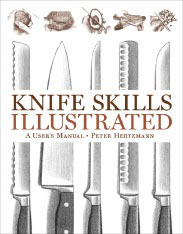
Knife Skills Illustrated
A User’s Manual
Peter Hertzmann
W.W. Norton & Co. (August, 2007); 256 pages; $29.95
Before supermarket produce cases were filled with plastic containers of melon cubes and bags of apple slices and lathe-turned “baby carrots,” there were knives. More precisely, there were more people in more kitchens who knew how to wield the oldest of culinary tools.
Peter Hertzmann’s book is an impassioned encouragement to readers that they pick up their blades and fearlessly core fennel, butterfly legs of lamb, and filet fish.
The author gained his own knife skills studying with Chinese and French chefs and working in restaurant kitchens. He passes on the advice of his mentors with grace and humility. Readers will do well to follow the author, mastering Chinese chef Martin Yan’s example of the “pinch grip,” before turning their knives to boning poultry or any of the other prep tasks illustrated here.
By his own admission, Peter Hertzmann is obsessive. So we have detailed drawings and text for each step involved—for filleting flat fish and “round” fish, for mincing both garlic and shallots, for trimming artichokes and asparagus—all of these for both right-handed and left-handed cooks.
One might expect Mr. Hertzmann to send us out to buy a new arsenal of blades at the local cooking emporium. But he’s a purist and a minimalist, convinced that one’s batterie de cuisine needs no more than two well-honed knives: a chef’s knife and a paring knife.
The author’s written explanations are clear and enhanced by exquisite drawings, which, like fine botanical or medical renderings, illuminate more than any photos might. So we must ask who made the editorial call to reduce to postage-stamp dimensions the illustrations for carving large birds and joints of meat? Everything need not be viewed full-size, but the deconstruction of a chicken warrants more space than the slicing of a garlic clove.
And because Mr. Hertzmann is so attentive to the anatomy, care, and safe-keeping of knives, we’d really welcome Mr. Witschonke’s illustration of the honing techniques described in the text. Here, one picture really would be worth a thousand words.
These minor imbalances should be easy enough to correct in a second edition of this useful manual.
###
Peter Hertzmann has taught knife skills and cooking at Sur La Table as well as privately in both France and the United States. He also authors the e-zine à la carte. He lives in Palo Alto, California
Disclosure: W.W. Norton sent us this book for our review.



